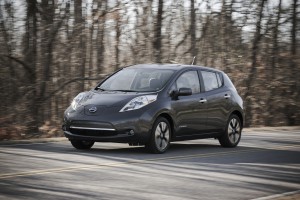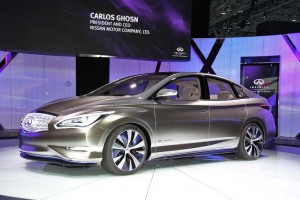What could be a critical year for the battery car market has gotten off to a shaky start. Demand for a number of the most familiar models took an unexpected skid in January, notably the Nissan Lead, whose U.S. sales fell by more than half from December.
Where that might discourage some manufacturers, however, Nissan officials have been sounding ever more upbeat. They dismiss the last month’s numbers as a temporary lull and insist the pace will pick up now that they’ve launched production at a new battery-car plant in Tennessee.
And they stress that demand is already on the rise in other key markets. In fact, the maker notes, they’ve now sold more than 50,000 of the pure battery-electric vehicles, or BEVs, since the launch of the Nissan Leaf in late 2010.
The second-largest of the Japanese makers was the first major maker to get back into the BEV segment since the mid-1990s when California abandoned a short-lived mandate aimed at promoting zero-emissions vehicles. By various estimates, Nissan has already invested well over $1 billion in its electrification program, with a second model, the Infiniti LE, due out about a year from now.
CEO Carlos Ghosn has been one of the industry’s most vocal proponents of battery power, emphasizing the potential benefits to the global environment at a time when climate change is all but an accepted certainty.
(Tesla and the NY Times tangle over a reporter’s review of the new Model S. Click Here for that report.)
What sort of impact is the Nissan Leaf having? Owners around the world have now covered a total distance of more than 160 million miles — nearing the distance from the earth to the sun and back, the maker claims.
Nissan likes to point out that these miles were covered with zero tailpipe emissions, contributing to government’s efforts to reduce levels of harmful NOx and particulate matter in cities. (Critics, however, note that there were still emissions from coal and gas-powered plants used to charge those Leafs, and nuclear waste, as well.)
The highest mileage Leaf globally has been revealed as one owned by a Japanese customer who has covered more than 110,000 miles, in a car that has only been on sale for two years. In 17 European countries, 7,000 cars are being driven every day, and one customer in Spain has already clocked up over 43,000 kilometers – or about 26,000 miles — in one year.
Nissan points to such high-mileage vehicles to help it deter concerns about battery life – something it recently addressed with a new warranty program. The maker also points to a customer satisfaction rating of over 95%, the highest of any Nissan vehicle.
Of course, the real question is getting more customers to buy the Leaf. January was clearly a setback, sales sliding to just 650, or a wee bit less than the 676 Nissan sold in January 2012 – and a sharp downturn from sales of 1,489 this past December, 1,539 in November and 1,579 in October.
The maker has insisted that U.S. sales have been restricted by a lack of availability as it expands into new markets around the world. So, with the new plant in Smyrna, Tennessee now ramping up production it will be the real test of demand in the months ahead.
The other challenge for Nissan – and its battery-car competitors – is a lack of a quick charging infrastructure. But that is also beginning to change. The number of these chargers which allow batteries to be recharged from empty to 80% battery capacity in around 30 minutes has jumped from 158 to 601 in the last 12 months.
The plans already in place are to more than double that tally by the end of this year. These units are being installed at strategic locations such as shopping center car parks or highway service stations, allowing the 50,000 Nissan Leaf owners to push the electric vehicle revolution even further.
Slower, so-called Level-II 240-volt chargers are also increasing in number. As TheDetroitBureau.com reported this week, NY Mayor Michael Bloomberg wants to see another 10,000 parking spaces set aside over the next several years for EV charging.
(For more on the Big Apple’s battery car plans, Click Here.)
Paul A. Eisenstein contributed to this report.


